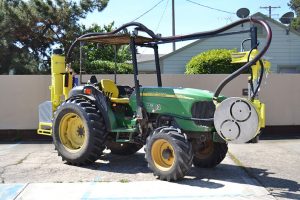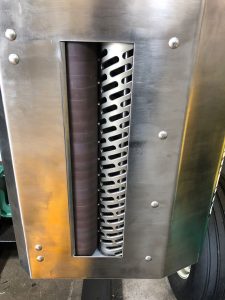 I must start by saying there really isn’t a mechanical leafer I’ve met that I didn’t like. It doesn’t matter what brand I’m working with, they all seem to do a good job. When they are not doing well, it seems to always be a timing issue. So, I thought it would be good to review the differences between the units.
I must start by saying there really isn’t a mechanical leafer I’ve met that I didn’t like. It doesn’t matter what brand I’m working with, they all seem to do a good job. When they are not doing well, it seems to always be a timing issue. So, I thought it would be good to review the differences between the units.
Let’s start with separating leafers into two categories: early season leafers and late season leafers. Early season leafers consist of the blow and shred method. Compressed air is blown out of a rotating nozzle giving the leaves a short vibrating pulse of air. This action shreds it and sends the particles out the other side of the canopy. The late season leafers use a suction and pluck system. This normally has a set of rollers in combination with the suction of a fan that draws leaves into the compression rollers to be pulled off.
Early season leafers (Fig. 1) can be started right after bloom and continue until the berries are around 5/16” in diameter. As with all leafers, the working head of the unit needs to be close to the canopy being leafed. They can shred up to 4” away but closer is always better. RPMs of the rotating nozzle can really help in the effect. When starting the season right after bloom, it would be normal to run at the higher rate of 900 RPM. This gives you a nice small leaf chunk being blown off. Towards the end of the season (¼” diameter +) you will start to see some nicks or cuts on the larger berries. This is caused by the leaf particles flying past the larger berries. These cuts later in the season can be minimized by slowing down the nozzle rotation RPM. The air pulses will be a bit slower producing a larger chunk of leaf. The larger chunk of leaf will act like a parachute and slow down as it goes thru the canopy.
 Average ground speed I have worked in goes from 1.3 up to 2.3 MPH. The best time for leafing with an air blast shredder is early in the morning to mid-afternoon. Once the temperature hits the mid to high 90’s, the leaves become rather pliable and you may need to drop a gear in speed to keep the same quality. Most air booster pumps generate up to 1 BAR (14.5 PSI) and when leafing in the Central Valley, I’ve never gone below that maximum setting. ½” nozzles seem to be a good starting point, although several nozzle sizes are available. The most important settings for these units are forward speed and RPM of the nozzle. Make sure that if you are dusting the field for mildew protection that you schedule in an application within a few days of leafing. It does a great job of blowing off leaves but will also take off sulfur.
Average ground speed I have worked in goes from 1.3 up to 2.3 MPH. The best time for leafing with an air blast shredder is early in the morning to mid-afternoon. Once the temperature hits the mid to high 90’s, the leaves become rather pliable and you may need to drop a gear in speed to keep the same quality. Most air booster pumps generate up to 1 BAR (14.5 PSI) and when leafing in the Central Valley, I’ve never gone below that maximum setting. ½” nozzles seem to be a good starting point, although several nozzle sizes are available. The most important settings for these units are forward speed and RPM of the nozzle. Make sure that if you are dusting the field for mildew protection that you schedule in an application within a few days of leafing. It does a great job of blowing off leaves but will also take off sulfur.
Late season leafers (Fig. 2) have to wait until the grapes become a certain size. (I always use ¼” as my starting point.) This is due to the fact that the machine can pull in the younger bunches and take them off. Their season runs up to verasion. Forward speeds are very similar to the early season leafers, in that same 1.3 to 2.3 MPH range. The head of the unit needs to be directly on the area to be leafed. Some units use electronic sensors to help follow and others have spring loaded systems to help hold them against the canopy.
 Late season leafers can be split into two additional categories. The first is direct suction fan style. These units use fans that run against the canopy creating suction and shearing off the leaves as they get drawn in. Most of the time there are some kind of screen rods that help keep the bunches out of the rotating fan blades. These fan styles are the first mechanical leafers ever introduced and are easy to work on. But setting the fan speed can be tricky and they can drag a lot of smaller bunches into the fan if you don’t watch it closely. The second category and newer version of late season leafers uses two rollers, one roller being the compression and the other is the vacuum roller. Vacuum is created by the suction of a small fan. Leaves are drawn against the vacuum roller and pinched slightly by the compression roller. This drags in the leaf and helps in keeping those more mature bunches out.
Late season leafers can be split into two additional categories. The first is direct suction fan style. These units use fans that run against the canopy creating suction and shearing off the leaves as they get drawn in. Most of the time there are some kind of screen rods that help keep the bunches out of the rotating fan blades. These fan styles are the first mechanical leafers ever introduced and are easy to work on. But setting the fan speed can be tricky and they can drag a lot of smaller bunches into the fan if you don’t watch it closely. The second category and newer version of late season leafers uses two rollers, one roller being the compression and the other is the vacuum roller. Vacuum is created by the suction of a small fan. Leaves are drawn against the vacuum roller and pinched slightly by the compression roller. This drags in the leaf and helps in keeping those more mature bunches out.
When starting your late season leafer, you normally start the vacuum roller to rotate at ground speed and then adjust up depending on the amount of leaves being pulled off. Never below ground speed. You should have a bit of clearance between the two rollers (1/16”+or-) and I normally like the harder durometer rubbers for the compression roll. Some companies offer a softer roller, but I think it wears out too quickly. Be very careful with spurs and canes. They can get dragged into the rollers and this will cause premature wear on those parts. You will also need a source of water to wash off the rollers as they build up in vegetable matter. This will need to be done once or twice daily.
In doing a maintenance cost comparison between the early and the late season leafers, we know that the late season leafer will require new rollers every 300-400 acres and some miscellaneous parts during the season. The early season leafer requires less yearly parts but after 10 +or- seasons, you may need to work on the blower system.
A similar challenge to all mechanical leafers is the trellis system. The flatter the area you can run against the better the job. In certain trellis systems and especially if you are leafing later in the year, you may have to trim first to get the clearance needed for the head. I can’t really give a thumbs up (or down) to the “electronic sensors” versus “just driving up against the canopy” argument. In talking with drivers and driving my own unit, both seem to work equally well.
I recommend two big purchasing rules for mechanical leafers: Don’t buy a double row machine, and only run a front mount. No rear mounts. Here’s what happens— It starts out great with an all new vineyard. But over the years the vines get bigger, the harvester leans the rows over a bit, we end up with spurs and arms that look more like a deer’s antlers, and/or the trellising system gets messed up somehow. Now when you are trying to hold a leafing head against a row that the driver can’t see, it gets to be a real problem. What commonly happens is that the driver moves further away from the vine to keep from hitting anything as well as getting out of the sensor range and starts to do a horrible job. After fighting this for a few seasons, the owner just puts the machine into the boneyard and goes back to hand leafing or trying the next best idea being sold. Save your money and look seriously into front mount single units and just drive keeping the single leafing head against the area. Easy to mount, easy to use, everybody wins. You get a good job at a fairly good rate of speed.
One thing is for sure– Both units do a great job if used in their perspective time periods. You can’t run an early season leafer when you are seeing verasion, and you can’t run a late season leafer after bloom. Unless you want to do some serious crop thinning.
Craig Edwards is the President of Acampo Machine Works, a vineyard equipment specialist company based in Lodi, California.
Have something interesting to say? Consider writing a guest blog article!
To subscribe to the Coffee Shop Blog, send an email to stephanie@lodiwine.com with the subject “blog subscribe.”
To join the Lodi Growers email list, send an email to stephanie@lodiwine.com with the subject “grower email subscribe” or click on “join our email list” to the right.
To receive Lodi Grower news and event promotions by mail, send your contact information to stephanie@lodiwine.com or call 209.367.4727.
For more information on the wines of Lodi, visit the Lodi Winegrape Commission’s consumer website, lodiwine.com.
To join the LODI RULES Sustainable Winegrowing Community as a grower or a vintner, email stephanie@lodiwine.com with the subject “LODI RULES.”


